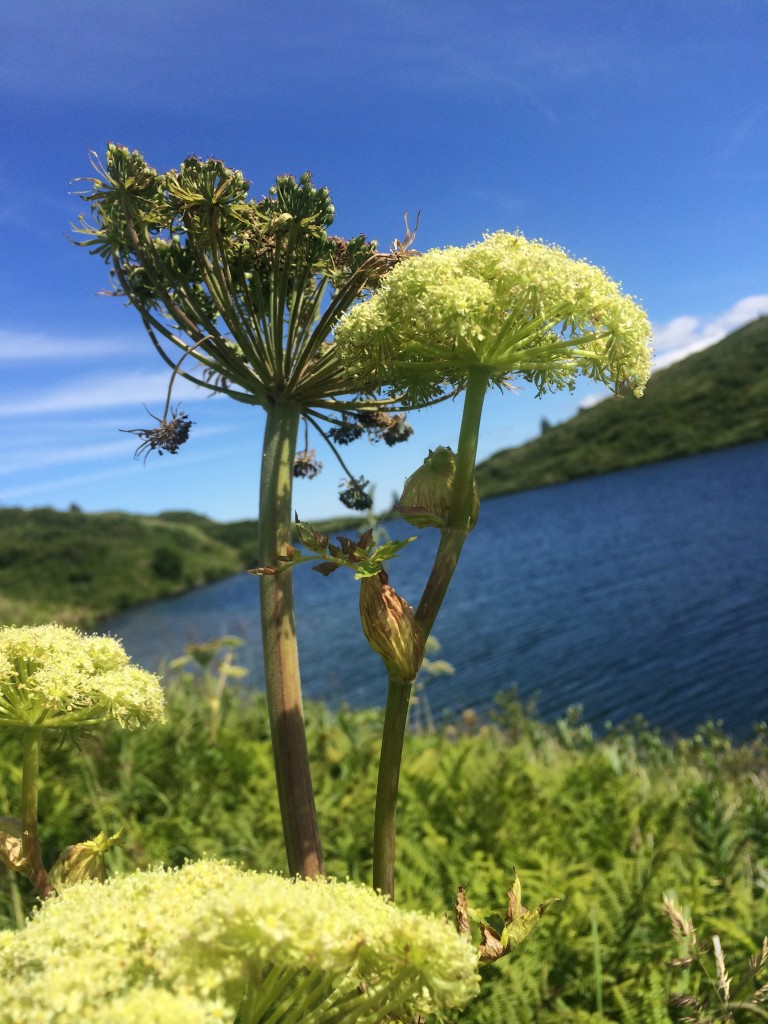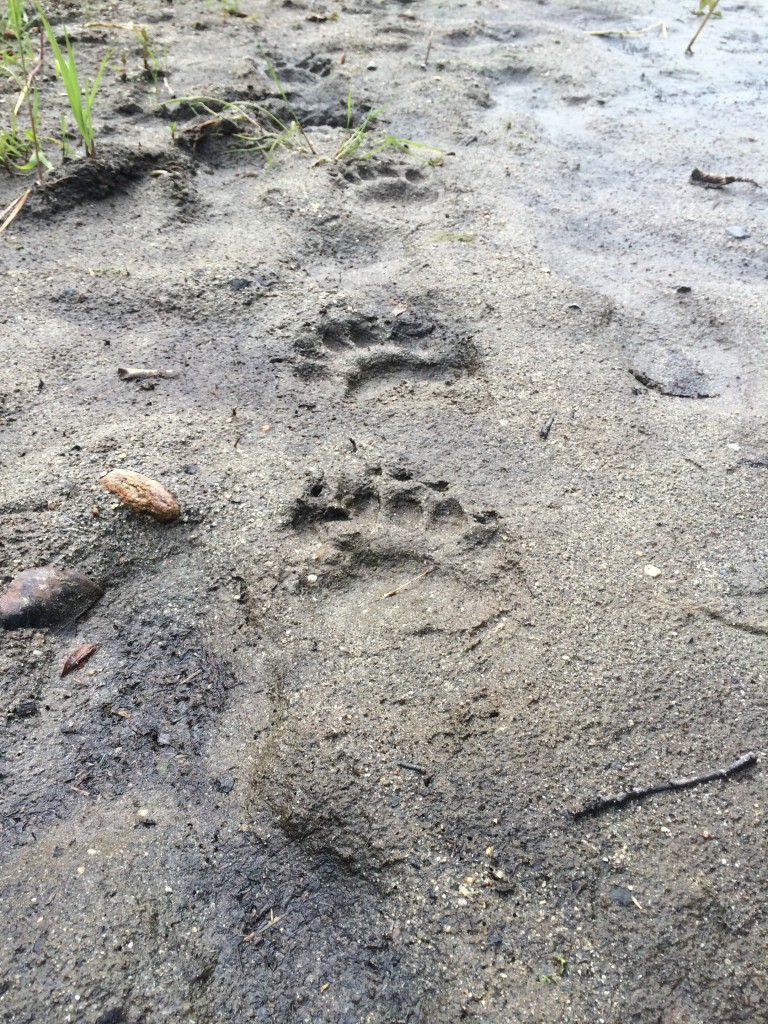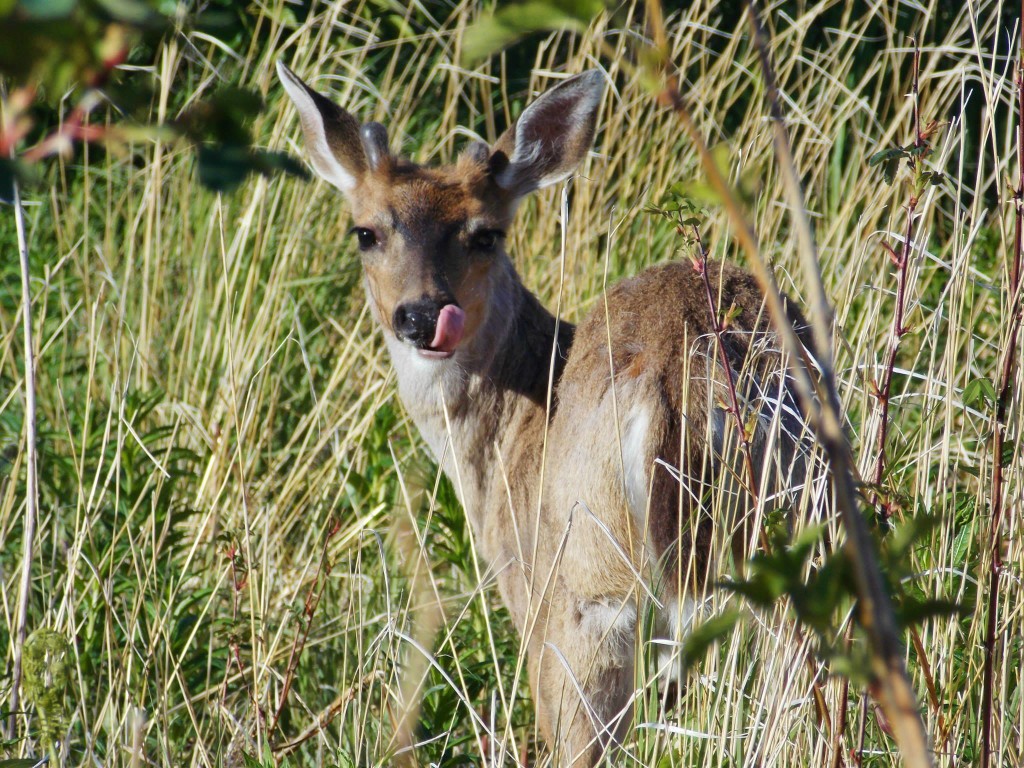Food from the Land
The Kodiak Island archipelago only has six native species of mammals. The rest were introduced to the island between the 1920s and 1950s. The native mammals include the Kodiak brown bear, red fox, river otter, ermine, little brown bat, and the tundra vole. The non-native, introduced species include the Sitka black-tailed deer, mountain goat, elk, reindeer, marten, red squirrel, snowshoe hare, and beaver. All of the introduced species are now hunted or trapped. Regulations for brown bear, Sitka black-tailed deer, elk, reindeer and mountain goat are published by the Alaska Department of Fish and Game. Current regulations are available in a printed booklet and online. As a hunter or trapper, it is your responsibility to check with the landowner before going out on your hunt. Please contact the U.S. Bureau of Land Management or the Alaska Department of Natural Resources to find out who owns the land.
Berries, Mushrooms, and Other Plants
A great variety of berries, mushrooms, and other plants are often harvested throughout the Kodiak archipelago. Harvesting small amounts of wild plants, mushrooms, berries, and other plant materials (excluding seaweeds) for personal, noncommercial use is generally allowed on state lands. On federal lands, no permit is required for the non-commercial harvest of berries, mushrooms, and other plant materials by federally qualified subsistence users. Here you can download the Kodiak Alutiiq Spring Plants book provided by the Native Educators of the Alutiiq Region


Brown bear
Brown bears on Kodiak Island are classified as a distinct subspecies from those on the Alaska’s mainland because they are genetically and physically different. Scientifically, they are known as Ursus arctic middendorffi. The population of brown bears on the Kodiak Archipelago is estimated at approximately 3,500 animals. Approximately 2,300 of these animals are found within the boundaries of the Kodiak National Wildlife Refuge. While both Alaska residents and nonresidents can hunt Kodiak brown bears, the hunts are highly regulated and require through research and evaluation of the regulations before hunting. The State of Alaska, through the Alaska Department of Fish and Game, manage and regulate Kodiak brown bear hunting within the Kodiak archipelago. For more information on the intricacies of hunting Kodiak brown bear, please review the Alaska Department of Fish and Game Kodiak Brown Bear Hunting FAQs.
Sitka Black-tailed Deer
In 1924, Sitka Black-tailed deer (Odocoileus hemionus sitkensis) were introduced to Kodiak. Since then the deer population has flourished and they are found throughout the Kodiak Island and on other island throughout the archipelago. The abundance of Sitka Black-tailed deer fluctuates annually due primarily to winter severity. Since deer have a high reproductive potential, reduced populations normally recover quickly. Deer meat, within the archipelago, is the most important land-based source of subsistence protein. During 2012 and 2014, the U.S. Fish and Wildlife Service conducted Sitka Black-tailed deer population surveys in an effort to estimate deer populations within the archipelago. Harvest tickets are required to hunt deer in the Kodiak archipelago. The season dates and bag limits can vary so make sure to check the current State of Alaska hunting regulations before hunting.

Elk
Within the Kodiak archipelago, Roosevelt elk (Cervus canadensis) were transplanted onto Afognak Island from Washington’s Olympic Peninsula in 1929. Since then some elk have migrated to Raspberry Island. Elk hunting with the Kodiak archipelago is managed by the Alaska Department of Fish and Game and opportunities are offered through drawing and registration hunts.
Reindeer (feral)
In 1921, reindeer were introduced to the southern area of Kodiak Island and ten years later an Alaska Native Cooperative, “The Alitak Native Reindeer Corporation”, was formed to managed the herd. Active management of the herd continued for 30 years and, shortly thereafter, federal grazing licenses ceased. In 1964, the State of Alaska declared the reindeer to be feral and started an open season, no bag limit hunt. This hunt remained unchanged for nearly 40 years when, in 2010, the State of Alaska instated a ban on same-day-airborne hunts and restricted the harvest opportunity to six months per year and one reindeer per hunter per year. Currently, hunting reindeer requires a hunting tag and the season is open from August 1st to January 31st.
Mountain Goat
Mountain goats (Oreamnus americanus) were introduced to Kodiak Island in 1952 and 1953. Since their transplantation, harvest numbers increased dramatically and the first hunting season occurred in 1968. In an effort to spread the mountain goat population throughout Kodiak Island, the state managed the populations conservatively. Currently, mountain goats occupy all available goat habitats on the Island. In 2014, 334 mountain goats were harvested from the Kodiak Island drawing and registration goat hunts. Mountain goat hunts are managed by registration and drawing permits. The taking of nannies with kids is prohibited and the taking of males is encouraged. Nonresident hunters must be accompanied by a guide. For more information about this hunt, please review the Alaska Department of Fish and Game regulation booklet.
Furbearers and Fur Animals
Furbearers and fur animals within the Kodiak archipelago include the red fox, snowshoe hare, beavers, river otter, red squirrel, and marten. The hunts for these animals are managed under the State of Alaska’s trapping regulations. Annually, the State of Alaska publishes summary of furbearer and fur animal trapping and hunting regulations.
Furbearers that may be taken with a trapping license include beaver, red fox, marten, mink, river otter, and squirrel. Some of these forbearers may also be classified as fur animals and these animals may be taken under the State of Alaska’s trapping regulations using a trapping license or under the hunting regulations using a hunting license. Before hunting or trapping these animals, please be sure to fully understand the regulations. For specific information about trapping on federal public lands, please call (800) 478-1456.
